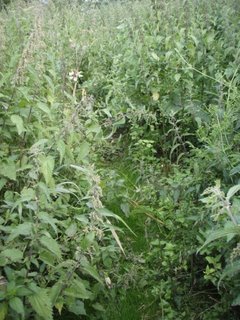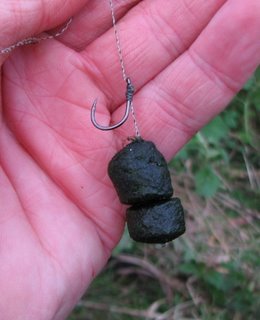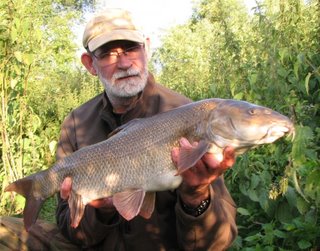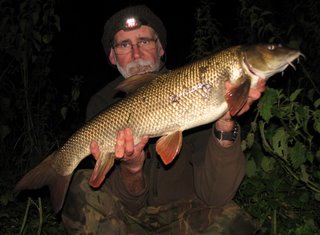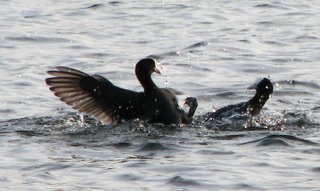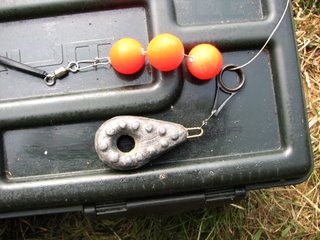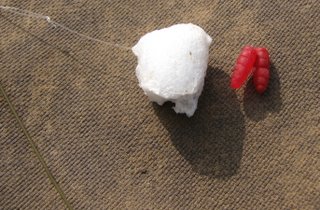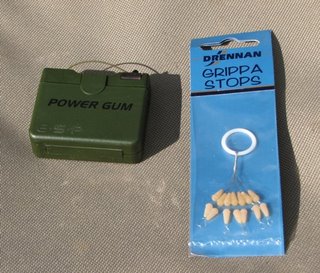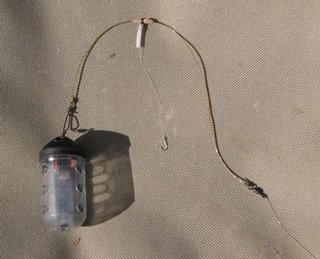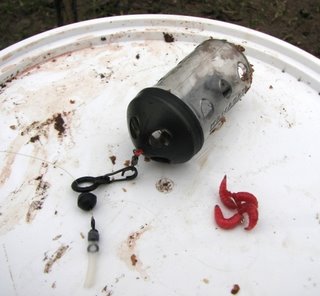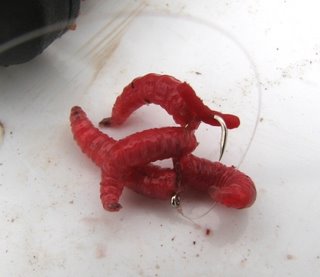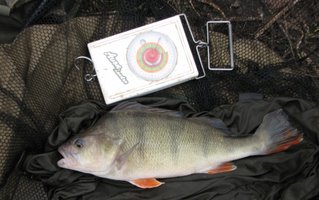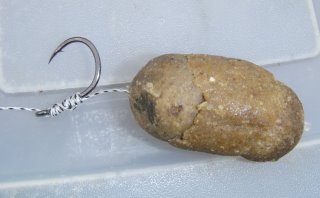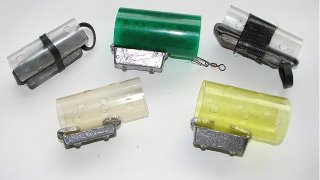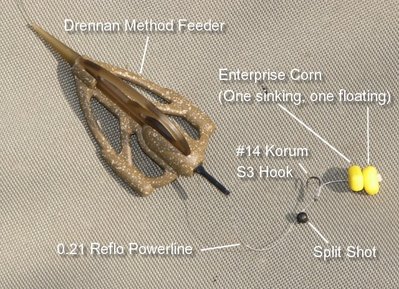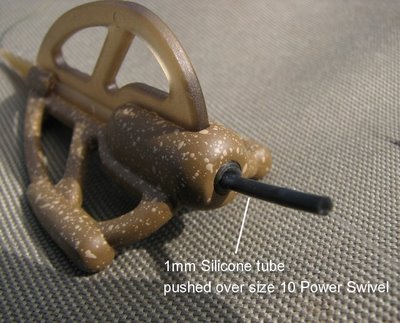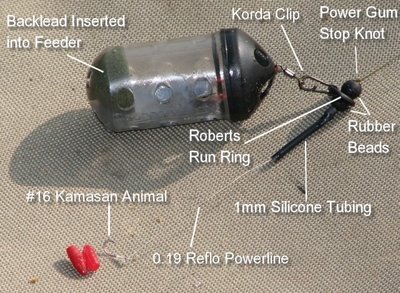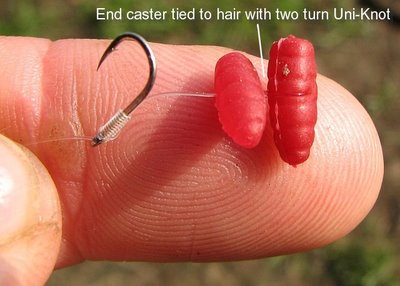A man can only take so much frustration and last week had been mighty frustrating. Even so, when I woke the rain was hammering on the window and I very nearly rolled over and went back to sleep. However the BBC on-line weather forecasts have proved to be pretty accurate when it comes to the 24hr predictions and this rain had been foretold to clear. Sure enough it began to ease, so I got up and loaded the car.
I'd been studying the pit I was heading for on
Flash Earth* and there appeared to be a shallow bar off a point that faced the prevailing wind. It had to be worth a look if the spot was free. Being almost as far from the car park as you can get it was free, despite my late arrival for a Sunday session. The barrow proved it's worth in getting a heavy load of bait round to the swim. The tackle I can manage, but a bucket of pre-soaked Vitalin and groats weighs a ton, plus there was dry groundbait and pellets adding to the load.
Out with the plumbing rod and there it was. At a couple or three feet it was rather shallower than I'd anticipated, but with twelve feet of water just beyond and to the left of the bar it had to be worth a shot. With the marker float in place in ten feet I set about catapulting out balls of Vitalin laced with groats and a mix of smallish pellets of various types. There were some groats remaining in the big bucket after I had tipped the mix into my groundbait bowl for balling up. Dry pellets were tipped in and water added. Once the catty had done its job the spod rod was used to put out the remaining pellets and groats over the top.
Some of the Vitalin mix was held back and half a bag of Sonu Carp Method Mix added to make a smoother mix to use on the two method feeders. One feeder was baited with a 10mm Tutti and the other with two grains of floating fake corn with a shot attached a quarter of an inch from the hook eye. The third rod was to fish a 15mm fishmeal boilie on a simple helicopter rig, with a PVA bag of crumbled boilies.
The helicopter rig consists of a quick change swivel trapped between two
Grippa Stops and Hiro Rollsnap (any snap link swivel will do) being tied to the end of the mainline. The hooklink has a rig sleeve on it to slide over the loop that slips into the quick change swivel. No tubing, no lead core. Dead simple.
 It don't get much more basic
It don't get much more basicAs the
Ballistas I built up for breaming last year haven't sold I decided to take them for an outing. They did a good job of casting the method feeders. At 2.5lb test so they should! I'd prefer a rod with a slightly softer butt section though.
 Posing as a carper
Posing as a carperThe day had brightened up and sheltered from the strong wind I was nice and warm. It still being spring the temperature soon dropped when a cloud obscured the sun though. With the wind blowing into the bay I expected bream to be in residence. Action wasn't anticipated until the sun started to sink. So I settled back on my bedchair to read a barbel book.
At five to two I was disturbed by the right hand bobbin lifting and holding. I gave it time to drop back in case it was a liner, but it stayed up. I lifted the rod, felt a weight then it was gone. Must have been a liner after all.
The next four hours were spend reading, listening to the wireless and being bemused by carp anglers. I think some carp anglers mustn't own an umbrella as they erect a bivvy for day sessions. And what's all this about facing away from the water? I know fishing into the wind can be unpleasant, but you can always manage to get the brolly (or whatever) arranged so you have at least a side on view of the rods. And if it isn't raining just wrap up warm!
For some reason I thought I'd recast the big boilie rod further out, maybe twenty yards more. I must have forgotten to switch the Delkim back on because twenty minutes later I heard a short, sharp buzz from a baitrunner. The bobbin on the big boilie rod was up at the top. This time when I lifted the rod the fish stayed attached. Fairly hooked it was a modest bream of some six pounds.
 15mm bream mouth
15mm bream mouthAround seven thirty the wind dropped, a cuckoo called, I had a liner, and a couple of bream rolled beyond my bait. An hour later the big boilie rod was in action again. The result being a slightly bigger bream which I weighed to see if my guesstimate was correct. It was. A shade over seven pounds. Another hour later with the light pretty much gone the liners started to increase in frequency. Most were gentle lifts and falls of the bobbin, but one whacked it up so hard the clip hit the rod butt and I was convinced it was the start of a carp run until it immediately dropped back! I now had the baits staggered with one beyond, one on, and one short of, the baited area. The bream were rolling with a vengeance, and the liners were coming constantly. At ten o'clock all three bobbins were in motion at once, Delkim lights flashing and buzzers tweeting quietly. One stayed up at the top longer than usual and the final, and smallest, bream of the session was landed.
On the way back to the car I knew there was a pothole I had to avoid with the barrow. I reached the place where it was, thought I had negotiated it, then promptly pushed the barrow into it. It was the perfect size to trap a wheelbarrow wheel. Bugger. Much heaving and cursing later I extricated the barrow and carried on. Stopping briefly to rebalance the load that had shifted during the mishap. Still, it was better than trying to carry the load back to the car.
No monsters caught, but I put some thought and effort in and didn't blank. Now I can face the workbench again. For a day or two at any rate.
* You didn't think that link would actually go to a view of the pit, did you?
Labels: bream, rigs














